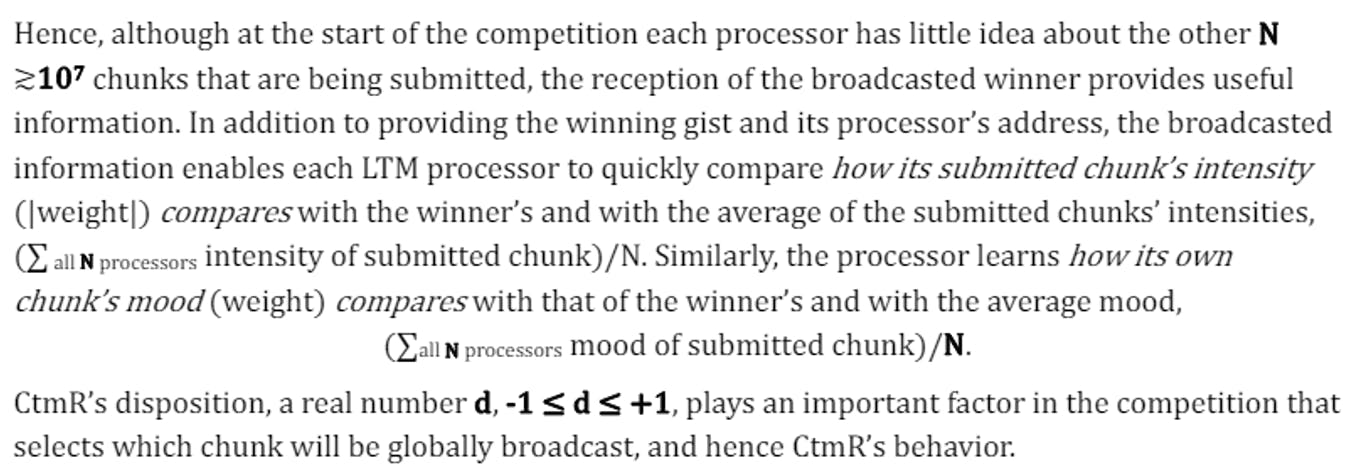
2024-9-4 10:15:14 Author: hackernoon.com(查看原文) 阅读量:1 收藏
Table of Links
2 Brief Overview of CtmR, a Robot with a CTM Brain
2.2 Conscious Attention in CtmR
2.3 Conscious Awareness and the Feeling of Consciousness in CtmR
2.4 CtmR as a Framework for Artificial General Intelligence (AGI)
3 Alignment of CtmR with Other Theories of Consciousness
4 Addressing Kevin Mitchell’s questions from the perspective of CtmR
7 Appendix
7.1 A Brief History of the Theoretical Computer Science Approach to Computation
7.2 The Probabilistic Competition for Conscious Attention and the Influence of Disposition on it
7.2 The Probabilistic Competition for Conscious Attention and the Influence of Disposition on it
We tried to make the CtmR Up-Tree competition deterministic, but it turns out to necessarily be probabilistic. This is because any deterministic competition must be made increasingly complex to realize essential properties. For example, this is the case if we want chunks of near equal |weight| to have near equal chances of getting onto the STM stage.
Consider a deterministic competition which makes decisions based on a chunks weight. Suppose chunk A is pinned to weight 11, chunk B to weight 9, and all other chunks to weight 0. In the deterministic CtmR competition, A always wins and B never does. And as long as weights don’t change, CtmR remains totally unconscious of chunk B. In the probabilistic CtmR competition described below (with the parameter d = 0), chunk A wins with probability 11/20 while B win with probability 9/20. So A and B each have roughly equal probability of winning a competition, and a new independent competition is begun at every clock tick. In that case, CtmR will likely become conscious of both.
In the probabilistic CtmR competition (a variant of the standard tennis or chess tournament) it is proved that a chunk wins the competition with probability proportional to (a function of) its weight. As a consequence, the winning chunk is independent of where processors are located! This is a property of CtmR’s probabilistic competition. (It is a property that would be difficult if not impossible to achieve in tennis and chess tournaments.)
We now describe the probabilistic competition. First recall that a chunk is a tuple, <pointer, time, gist, weight, auxiliary information> consisting of a pointer to the originating processor, the time the chunk was put into the competition, a succinct Brainish gist of information, a valenced weight (to indicate the importance/ value/ confidence the originating processor assigns its gist), and some auxiliary information.
For the probabilistic CtmR, the auxiliary information is a pair of numbers which we call (intensity, mood).
At the start of the competition, each LTM processor enters a chunk into its leaf node with
intensity = |weight| and mood = weight.
In the probabilistic competition, each non-leaf node of the Up-Tree contains a coin-toss neuron.
The coin-toss neuron probabilistically chooses the local winner of the two (competing) chunks in the node’s two children based on their f values, where
f(chunk) = intensity + d•(mood) and -1 ≤ d ≤ +1.
Here d is a constant called CtmR’s disposition.
If C1 and C2 are the two competing chunks, then the coin toss neuron will choose Ci to be the local winner with probability f(Ci)/f(C1)+f(C2).
The local winner will move up one level in a single clock tick. The first four parameters of this new chunk are the same as the local winner’s. But its intensity is the sum of two competing chunks’ intensities. Similarly for its mood.
Thus, as a chunk moves up the tree, the intensity never decreases. This is not (necessarily) the case for the mood.
In this way, the winning chunk’s auxiliary information at the end of the competition will contain the sum of all submitted chunks’ intensities (|weights|) and the sum of all submitted moods (weights).

If the disposition is d > 0, CtmR will be “upbeat” in the sense that positively valenced chunks will have a higher probability of winning than negatively weighted chunks of the same |weight|. If its disposition is d = +1, CtmR is manic: only positively valenced chunks can win the competition. The CtmR knows only what is positive in its life, as long as anything is positive.
If the disposition is d < 0, CtmR will be “downbeat”. If d = -1, CtmR is “hopelessly depressed”, only negatively valenced chunks can win the competition. There is no way out of this horrible state except with a reboot, i.e., to “shock” the system to get a less extreme disposition.[35]
[35] If d=+1, CtmR is in the manic state, and CtmR theory suggests that there too, a reboot is warranted.
In humans, electroconvulsive therapy (ECT) is used primarily for depression. The CtmR model suggests that ECT might work as well for mania. Despite the fact that “ECT is a rapid and highly effective treatment of manic episodes”, current guidelines only endorse ECT “for pharmacotherapy-resistant mania but often as second- or third-line treatment.” (Elias, Thomas, & Sackeim, 2021).
如有侵权请联系:admin#unsafe.sh